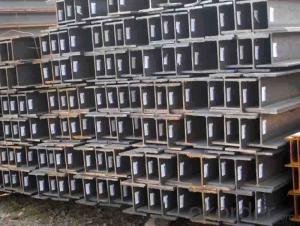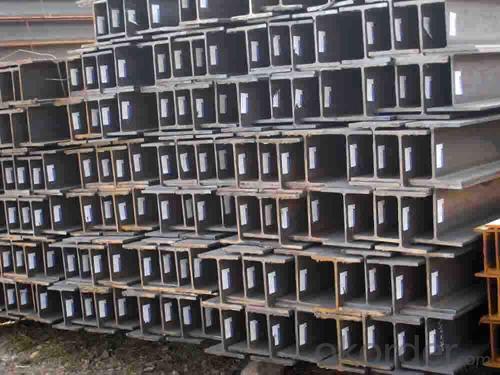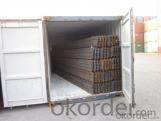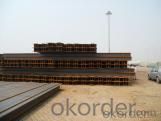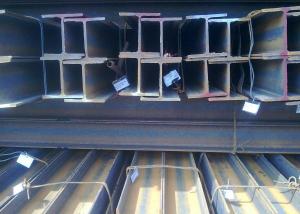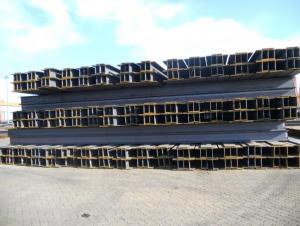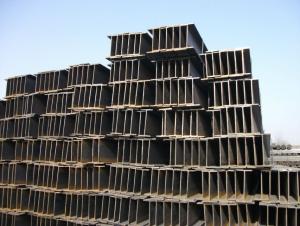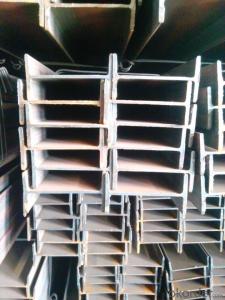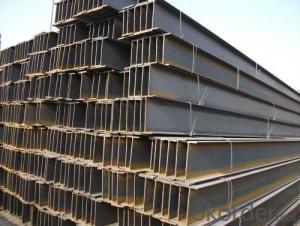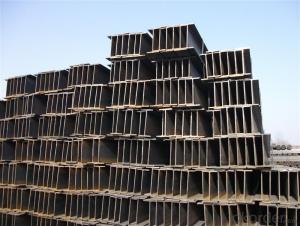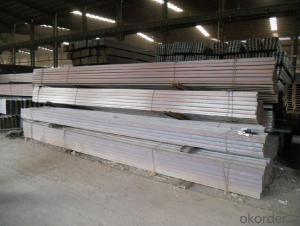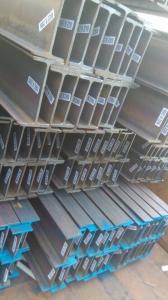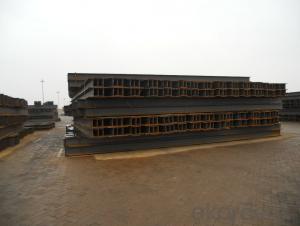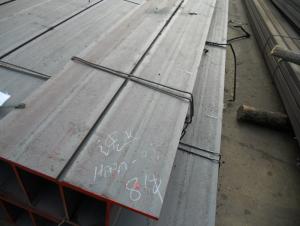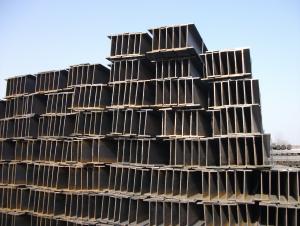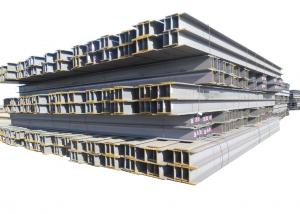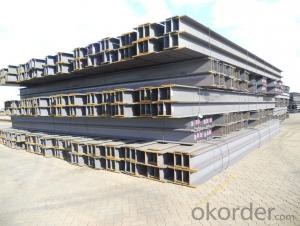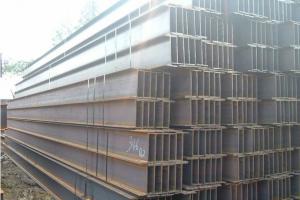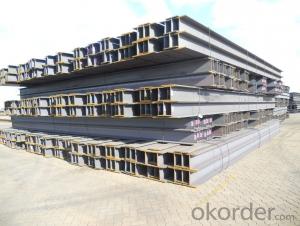Hot Rolled Steel H Beam SS400 with high quality
- Loading Port:
- Tianjin
- Payment Terms:
- TT or LC
- Min Order Qty:
- 25 m.t.
- Supply Capability:
- 100000 m.t./month
OKorder Service Pledge
OKorder Financial Service
You Might Also Like
Product Description:
OKorder is offering Hot Rolled Steel H Beam SS400 with high qualityat great prices with worldwide shipping. Our supplier is a world-class manufacturer of steel, with our products utilized the world over. OKorder annually supplies products to European, North American and Asian markets. We provide quotations within 24 hours of receiving an inquiry and guarantee competitive prices.
Product Applications:
Hot Rolled Steel H Beam SS400 with high quality are ideal for structural applications and are widely used in the construction of buildings and bridges, and the manufacturing, petrochemical, and transportation industries.
Product Advantages:
OKorder's Hot Rolled Steel H Beam SS400 with high quality are durable, strong, and resist corrosion.
Main Product Features:
· Premium quality
· Prompt delivery & seaworthy packing (30 days after receiving deposit)
· Corrosion resistance
· Can be recycled and reused
· Mill test certification
· Professional Service
· Competitive pricing
Product Description:
Specifications of Hot Rolled Structural Steel H Beam
1. Standard: GB700-88, Q235B2.
2. Grade: Q235, SS400 or Equivalent
3. Length: 6m,10m, 12m as following table
4. Invoicing on theoretical weight or actual weight as customer request
5.Payment: TT or L/C
Usage & Applications of Hot Rolled Structural Steel H Beam
Commercial building structure ;Pre-engineered buildings; Machinery support structure; Prefabricated structure; Medium scale bridges; Ship-building structure. etc.
Packaging & Delivery of Hot Rolled Structural Steel H Beam
1. Packing: it is nude packed in bundles by steel wire rod
2. Bundle weight: not more than 3.5MT for bulk vessel; less than 3 MT for container load
3. Marks:
Color marking: There will be color marking on both end of the bundle for the cargo delivered by bulk vessel. That makes it easily to distinguish at the destination port.
Tag mark: there will be tag mark tied up on the bundles. The information usually including supplier logo and name, product name, made in China, shipping marks and other information request by the customer.
If loading by container the marking is not needed, but we will prepare it as customer request.
4. Transportation: the goods are delivered by truck from mill to loading port, the maximum quantity can be loaded is around 40MTs by each truck. If the order quantity cannot reach the full truck loaded, the transportation cost per ton will be little higher than full load.
5. Delivered by container or bulk vessel
Production flow of Hot Rolled Structural Steel H Beam
Material prepare (billet) —heat up—rough rolling—precision rolling—cooling—packing—storage and transportation
FAQ:
Q1: Why buy Materials & Equipment from OKorder.com?
A1: All products offered byOKorder.com are carefully selected from China's most reliable manufacturing enterprises. Through its ISO certifications, OKorder.com adheres to the highest standards and a commitment to supply chain safety and customer satisfaction.
Q2: Can fit in the containers of 20fts the steel beams of 6M?
A2: No proble, we can put them into the containers in the form sideling.
Q3: The products are invoicing on theoritical weight or on actual weight?
A3: We can do it in both manners, according to the customers' request.
Images:
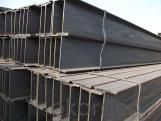
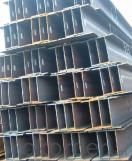
- Q: How do steel H-beams contribute to the overall sustainability of a transportation hub?
- Steel H-beams contribute to the overall sustainability of a transportation hub in several ways. Firstly, steel H-beams are known for their structural strength and durability, making them an ideal choice for constructing large-scale transportation hubs. Due to their high strength-to-weight ratio, H-beams require fewer materials to achieve the same level of structural support, resulting in reduced resource consumption. This not only helps to conserve natural resources but also minimizes the environmental impact associated with the extraction, manufacturing, and transportation of construction materials. Furthermore, steel H-beams are recyclable, meaning that they can be repurposed or reused at the end of their lifespan. This attribute aligns with the principles of a circular economy, which aims to minimize waste and maximize resource efficiency. By incorporating recyclable materials like steel H-beams into the construction of transportation hubs, we can reduce the amount of construction waste sent to landfills and promote a more sustainable approach to infrastructure development. In addition to their strength and recyclability, steel H-beams also contribute to the sustainability of transportation hubs through their ability to withstand extreme weather conditions. These beams offer excellent resistance to forces such as high winds, earthquakes, and heavy loads, thereby ensuring the long-term stability and safety of the transportation hub. This resilience reduces the need for frequent repairs or replacements, saving both time and resources in the long run. Lastly, steel H-beams can be prefabricated offsite, allowing for efficient construction processes and minimizing disruption to the surrounding environment. Prefabrication reduces construction time, energy consumption, and waste generation, all of which contribute to the overall sustainability of the transportation hub. In conclusion, steel H-beams play a vital role in enhancing the overall sustainability of a transportation hub. Their strength, durability, recyclability, resistance to extreme weather, and ability to be prefabricated contribute to reducing resource consumption, promoting a circular economy, minimizing waste, and ensuring long-term stability. By incorporating steel H-beams into the design and construction of transportation hubs, we can create more sustainable and resilient infrastructure for the future.
- Q: How are steel H-beams protected against corrosion during construction?
- During construction, steel H-beams undergo galvanization to protect them from corrosion. Galvanization involves applying a layer of zinc to the steel beams, either through hot-dip galvanization or electroplating. In the hot-dip galvanization process, the steel beams are first cleaned to remove impurities and contaminants. They are then immersed in molten zinc, which adheres to the surface of the beams. This creates a protective layer of zinc that acts as a barrier against corrosion. Alternatively, electroplating can be used to protect steel H-beams from corrosion. This method involves depositing a thin layer of zinc onto the surface of the beams using an electric current. The zinc ions bond with the steel, forming a protective coating. Both hot-dip galvanization and electroplating offer excellent corrosion resistance to steel H-beams. The zinc layer acts as a sacrificial coating, meaning that if the beams are exposed to moisture or corrosive elements, the zinc will corrode before the steel. This sacrificial action helps prolong the lifespan of the beams and prevent structural damage caused by corrosion. Overall, galvanization is crucial in safeguarding steel H-beams from corrosion during construction. By applying a layer of zinc, these beams can endure harsh environmental conditions and maintain their structural integrity over time.
- Q: Can steel H-beams be used in underground construction projects?
- Yes, steel H-beams can be used in underground construction projects. Steel H-beams are commonly used in various construction projects due to their strength, durability, and versatility. In underground construction, these beams can be used to create structural support systems or frameworks for tunnels, underground parking lots, subways, or basements. They are capable of withstanding heavy loads and provide excellent resistance against various forces, such as compression and tension, making them suitable for underground environments. Additionally, steel H-beams can be easily assembled and disassembled, allowing for flexibility and adaptability in underground construction projects. Overall, steel H-beams are a reliable and efficient choice for underground construction projects.
- Q: How do you calculate the deflection limits for steel H-beams?
- To calculate the deflection limits for steel H-beams, several factors need to be taken into consideration. The deflection limits are typically determined by the applicable building codes or industry standards. The following steps outline the general process of calculating the deflection limits: 1. Determine the relevant building code or industry standard: The deflection limits are usually specified by building codes or industry standards, such as the American Institute of Steel Construction (AISC) code. These codes provide guidelines for the maximum permissible deflection based on the intended use of the structure. 2. Identify the properties of the H-beam: Gather the necessary information about the H-beam, including its dimensions, material properties, and support conditions. This information is typically provided by the manufacturer or can be obtained from relevant design resources. 3. Calculate the moment of inertia: The moment of inertia is a measure of the beam's resistance to bending. It is calculated based on the beam's dimensions and geometry. The moment of inertia plays a crucial role in determining the deflection of the beam. 4. Determine the applied load: Identify the load or loads that will act on the H-beam. This could include dead loads, live loads, wind loads, or any other relevant loads as specified by the design requirements. 5. Apply the appropriate deflection formula: The specific deflection formula to be used will depend on the type of loading and support conditions. Common deflection formulas include the Euler-Bernoulli beam equation, which assumes linear elastic behavior, and the Timoshenko beam equation, which accounts for shear deformations. 6. Calculate the maximum allowable deflection: Using the deflection formula, input the relevant parameters such as the applied load, beam properties, and support conditions to calculate the deflection at various points along the beam. Compare the calculated deflection values to the deflection limits specified in the building code or industry standard. 7. Ensure compliance with deflection limits: If the calculated deflection exceeds the specified limits, adjustments need to be made to the beam's dimensions, material, or support conditions. This may involve increasing the beam size, using a higher-strength material, or adding additional support. It is important to note that the process of calculating deflection limits for steel H-beams can be complex and may require the expertise of a structural engineer or designer. Additionally, it is crucial to adhere to the applicable building codes and industry standards to ensure the safety and structural integrity of the project.
- Q: Can steel H-beams be used in the construction of military or defense buildings?
- Yes, steel H-beams can be used in the construction of military or defense buildings. Steel H-beams are known for their high strength and durability, making them suitable for structures that require resistance against extreme conditions and potential threats. Additionally, their versatility allows for flexible design and construction options, making them a reliable choice for military and defense-related projects.
- Q: How do Steel H-Beams contribute to the overall life cycle assessment of a structure?
- Steel H-beams contribute to the overall life cycle assessment of a structure in several ways. Firstly, these beams are commonly used as structural components in buildings, bridges, and other infrastructure projects due to their high strength and durability. The use of steel H-beams in construction helps to ensure the longevity and stability of the structure, which is a crucial aspect of the life cycle assessment. Additionally, steel H-beams have a high recyclability rate, meaning that they can be easily recovered and reused at the end of their life cycle. This promotes sustainability and reduces the environmental impact of the structure. Steel is one of the most recycled materials globally, and the use of H-beams contributes to the circular economy by minimizing waste and conserving natural resources. Moreover, the manufacturing process of steel H-beams has become more energy-efficient and environmentally friendly over the years. Advanced technologies, such as electric arc furnaces and energy recovery systems, are employed to reduce energy consumption and greenhouse gas emissions during production. This improvement in manufacturing practices positively impacts the life cycle assessment by reducing the embodied energy and carbon footprint of the structure. Furthermore, steel H-beams are known for their design flexibility and adaptability. They can be easily modified or replaced, allowing for future structural modifications or repurposing of the building. This adaptability extends the life cycle of the structure and reduces the need for complete demolition and reconstruction, which would have a significant environmental impact. In summary, steel H-beams contribute to the overall life cycle assessment of a structure by providing strength, durability, and stability. Their high recyclability, energy-efficient manufacturing, and design flexibility promote sustainability and reduce environmental impacts. By considering the use of steel H-beams in construction projects, we can enhance the overall performance and longevity of structures while minimizing their ecological footprint.
- Q: What does "H400*250*8*12" mean in steel structures?
- Total domestic steel structure (special) level of construction enterprises 143, an increase of 427 qualification for steel structure, with a qualification for steel structure enterprises amounted to 570! Recently, Shanghai Metal Structure Association statistics data show that in the city of Shanghai Metal Structure Industry Association member units, steel fabrication and installation of enterprises (including some provinces and municipalities) a total of 380, the annual output of 3 million 600 thousand tons, and it is said that only the Shanghai area registered steel construction enterprises reached five hundred or six hundred. The development of steel structure industry, like China history the Warring States period, the steel structure enterprises from dozens to thousands, but with an annual output of 100 thousand tons of enterprises is very small, the formation of the rapid development of the market, and industry concentration is more and more low contrast. The reason is the main steel structure industry low barriers to entry, whether it is money or technical requirements are not too high.
- Q: How do steel H-beams perform in structures with large openings and openings for services?
- Due to their exceptional structural performance, steel H-beams are extensively utilized in structures featuring expansive openings and service openings. These beams possess impressive strength and stiffness, enabling them to span long distances and support heavy loads. In structures with sizable openings, steel H-beams offer the possibility of creating vast, unobstructed spaces without the need for intermediary support columns. This allows for greater design flexibility and layout options, maximizing the usable area and providing an unimpeded view. Additionally, steel H-beams can easily accommodate service openings for HVAC ducts, plumbing, electrical conduits, and other utilities. These openings can be effortlessly integrated into the beams through cutting or drilling, without compromising the overall structural integrity. Consequently, steel H-beams prove to be a versatile choice for structures that necessitate the integration of various services. Furthermore, steel H-beams exhibit remarkable fire resistance properties, maintaining their load-carrying capacity for a prolonged period even in high-temperature conditions. This feature is crucial in structures with large or service openings, as it adds an extra layer of safety during fire emergencies. Moreover, steel H-beams are highly durable and resistant to corrosion, ensuring the longevity and dependability of the structure. They require minimal maintenance and can endure harsh environmental conditions, making them suitable for both interior and exterior applications. In conclusion, steel H-beams excel in structures featuring large or service openings. Their strength, flexibility, fire resistance, and durability make them an ideal choice for such applications, providing a secure, efficient, and long-lasting structural solution.
- Q: How do steel H-beams contribute to energy efficiency in buildings?
- Steel H-beams contribute to energy efficiency in buildings by providing a strong structural framework that allows for larger open spaces and flexible design. This enables the use of natural lighting and ventilation, reducing the need for artificial lighting and air conditioning. Additionally, steel H-beams have high thermal conductivity, which helps in maintaining a consistent indoor temperature and reducing energy consumption for heating and cooling.
- Q: Can steel H-beams be used for shopping complexes?
- Yes, steel H-beams can be used for shopping complexes. They are commonly used in the construction industry due to their strength and durability. Steel H-beams offer excellent structural support and can withstand heavy loads, making them suitable for large commercial buildings like shopping complexes.
Send your message to us
Hot Rolled Steel H Beam SS400 with high quality
- Loading Port:
- Tianjin
- Payment Terms:
- TT or LC
- Min Order Qty:
- 25 m.t.
- Supply Capability:
- 100000 m.t./month
OKorder Service Pledge
OKorder Financial Service
Similar products
Hot products
Hot Searches
Related keywords
